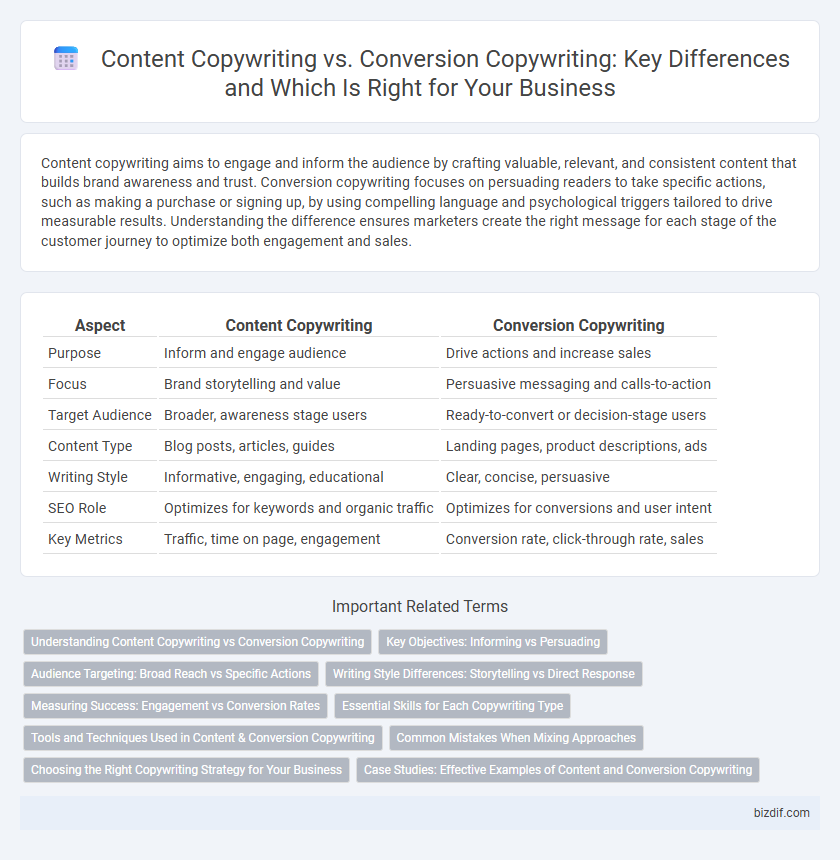Content copywriting aims to engage and inform the audience by crafting valuable, relevant, and consistent content that builds brand awareness and trust. Conversion copywriting focuses on persuading readers to take specific actions, such as making a purchase or signing up, by using compelling language and psychological triggers tailored to drive measurable results. Understanding the difference ensures marketers create the right message for each stage of the customer journey to optimize both engagement and sales.
Table of Comparison
| Aspect | Content Copywriting | Conversion Copywriting |
|---|---|---|
| Purpose | Inform and engage audience | Drive actions and increase sales |
| Focus | Brand storytelling and value | Persuasive messaging and calls-to-action |
| Target Audience | Broader, awareness stage users | Ready-to-convert or decision-stage users |
| Content Type | Blog posts, articles, guides | Landing pages, product descriptions, ads |
| Writing Style | Informative, engaging, educational | Clear, concise, persuasive |
| SEO Role | Optimizes for keywords and organic traffic | Optimizes for conversions and user intent |
| Key Metrics | Traffic, time on page, engagement | Conversion rate, click-through rate, sales |
Understanding Content Copywriting vs Conversion Copywriting
Content copywriting focuses on creating engaging, informative text that builds brand awareness and nurtures audience relationships. Conversion copywriting targets persuasive language designed to drive specific actions such as sales, sign-ups, or clicks. Understanding the distinction between these two types helps marketers tailor their messaging strategies for maximum impact.
Key Objectives: Informing vs Persuading
Content copywriting focuses on informing audiences by providing valuable, relevant information to build brand awareness and trust. Conversion copywriting targets persuasion, crafting compelling calls-to-action that drive specific user actions and increase sales or leads. Both approaches require understanding the audience, but content emphasizes education while conversion centers on motivating decisions.
Audience Targeting: Broad Reach vs Specific Actions
Content copywriting aims to engage a broad audience by providing valuable information that appeals to diverse interests, enhancing brand awareness and trust. Conversion copywriting focuses on targeting specific segments with persuasive language designed to drive immediate actions such as clicks, sign-ups, or purchases. Effective audience targeting in content copywriting builds relationships over time, while conversion copywriting uses data-driven insights to optimize messaging for high-impact results.
Writing Style Differences: Storytelling vs Direct Response
Content copywriting employs storytelling techniques that engage readers through narrative elements, fostering emotional connections and brand awareness. Conversion copywriting prioritizes direct response by using clear, concise language and persuasive calls-to-action designed to drive immediate user behavior. The writing style in content copywriting is more descriptive and immersive, while conversion copywriting strips away fluff to focus on urgency and measurable outcomes.
Measuring Success: Engagement vs Conversion Rates
Content copywriting drives audience engagement by creating valuable, informative, and relevant content that attracts and retains readers, measured through metrics such as time on page, social shares, and bounce rates. Conversion copywriting focuses on persuading readers to take specific actions like purchasing or signing up, with success measured by conversion rates, click-through rates, and sales volume. Understanding these distinct metrics helps businesses tailor their copywriting strategy to either nurture relationships or directly boost revenue.
Essential Skills for Each Copywriting Type
Content copywriting requires strong storytelling, research, and SEO skills to create engaging, informative texts that attract and retain audience attention. Conversion copywriting demands expertise in persuasive language, A/B testing, and understanding consumer psychology to effectively drive actions and increase sales. Mastery of audience targeting and clear call-to-actions are crucial for both types but applied differently to meet distinct goals.
Tools and Techniques Used in Content & Conversion Copywriting
Content copywriting employs tools like SEO analyzers, keyword research platforms, and content management systems to optimize readability and search engine rankings. Conversion copywriting relies heavily on A/B testing software, heatmaps, and customer analytics to craft persuasive copy that drives user actions. Techniques in content copywriting prioritize informative storytelling and engagement, while conversion copywriting uses psychological triggers and strong calls-to-action to maximize conversions.
Common Mistakes When Mixing Approaches
Mixing content copywriting and conversion copywriting often leads to unclear messaging that confuses readers instead of inspiring action. Common mistakes include overloading content with sales-heavy language that drives visitors away or creating informative content that lacks persuasive calls to action, resulting in missed conversion opportunities. Maintaining a clear distinction between engagement-focused storytelling and goal-driven copy maximizes effectiveness in both brand building and lead generation.
Choosing the Right Copywriting Strategy for Your Business
Content Copywriting focuses on creating informative, engaging material that builds brand awareness and educates the audience, while Conversion Copywriting aims to persuade readers into taking specific actions like purchasing or signing up. Selecting the right copywriting strategy depends on business goals; if the objective is nurturing leads and providing value, content copywriting is ideal, whereas businesses seeking direct sales growth should prioritize conversion copywriting. Analyzing target audience behavior and sales funnel stages ensures the chosen approach aligns with your marketing objectives for maximum impact.
Case Studies: Effective Examples of Content and Conversion Copywriting
Case studies in content copywriting showcase how in-depth storytelling and audience engagement drive brand awareness and trust, as seen in HubSpot's blog growth strategy generating a 217% increase in organic traffic. Conversion copywriting case studies, such as Basecamp's homepage revision, demonstrate improved call-to-action clarity and persuasive messaging that led to a 14% boost in sign-ups. Analyzing these examples highlights the distinct objectives and measurable outcomes of content versus conversion copywriting in digital marketing campaigns.
Content Copywriting vs Conversion Copywriting Infographic

 bizdif.com
bizdif.com